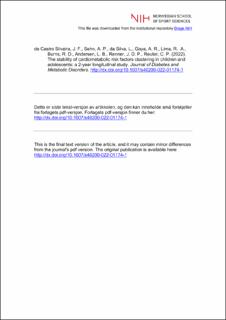| dc.contributor.author | de Castro Silveira, João Francisco | |
| dc.contributor.author | Sehn, Ana Paula | |
| dc.contributor.author | da Silva, Luiza | |
| dc.contributor.author | Gaya, Anelise Reis | |
| dc.contributor.author | Lima, Rodrigo Antunes | |
| dc.contributor.author | Burns, Ryan Donald | |
| dc.contributor.author | Andersen, Lars Bo | |
| dc.contributor.author | Renner, Jane Dagmar Pollo | |
| dc.contributor.author | Reuter, Cézane Priscila | |
| dc.date.accessioned | 2023-03-16T08:23:57Z | |
| dc.date.available | 2023-03-16T08:23:57Z | |
| dc.date.created | 2023-01-09T13:31:56Z | |
| dc.date.issued | 2022 | |
| dc.identifier.citation | Journal of Diabetes and Metabolic Disorders. 2022. | en_US |
| dc.identifier.issn | 2251-6581 | |
| dc.identifier.uri | https://hdl.handle.net/11250/3058604 | |
| dc.description | Dette er siste tekst-versjon av artikkelen, og den kan inneholde små forskjeller fra forlagets pdf-versjon. Forlagets pdf-versjon finner du her: springerlink.com / This is the final text version of the article, and it may contain minor differences from the journal's pdf version. The original publication is available here: springerlink.com | en_US |
| dc.description.abstract | Objective: The present study aims to verify the odds of remaining with the clustering of 3 or more, 4 or more, and 5 or more risk factors across a 2-year time span. Methods: Observational longitudinal study that included 358 children and adolescents (10.96 ± 2.28 years of age at baseline). Cardiorespiratory fitness, glucose, systolic blood pressure, total cholesterol/high-density lipoprotein cholesterol ratio, triglycerides, and waist circumference were assessed. The number of children in whom the risk factors were not independently distributed was analyzed. Odds ratios of presenting n risk factors clustered at follow-up according to the number of risk factors observed at baseline were calculated. Results: More participants than expected were found presenting clustering of 4 or more and 5 or more risk factors at both baseline (11.7% and 5.6%, respectively) and follow-up (9.5% and 5.6%, respectively). The odds ratios calculated demonstrated that the odds of presenting the same number of risk factors clustered or more at follow-up increased according to the number of risk factors clustered at baseline. Conclusion: The higher the number of risk factors a child had at baseline, the higher the odds of presenting the same number of risk factors or more after two years of follow-up. | en_US |
| dc.language.iso | eng | en_US |
| dc.subject | cardiovascular disease | en_US |
| dc.subject | chronic disease | en_US |
| dc.subject | metabolic syndrome | en_US |
| dc.subject | pediatric | en_US |
| dc.title | The stability of cardiometabolic risk factors clustering in children and adolescents: a 2-year longitudinal study | en_US |
| dc.title.alternative | The stability of cardiometabolic risk factors clustering in children and adolescents: a 2-year longitudinal study | en_US |
| dc.type | Peer reviewed | en_US |
| dc.type | Journal article | en_US |
| dc.description.version | acceptedVersion | en_US |
| dc.source.pagenumber | 7 | en_US |
| dc.source.journal | Journal of Diabetes and Metabolic Disorders | en_US |
| dc.identifier.doi | 10.1007/s40200-022-01174-1 | |
| dc.identifier.cristin | 2103297 | |
| dc.description.localcode | Institutt for idrettsmedisinske fag / Department of Sports Medicine | en_US |
| cristin.ispublished | true | |
| cristin.fulltext | postprint | |
| cristin.qualitycode | 1 | |
